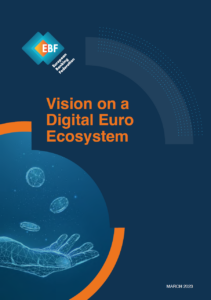X
X
 EBF Vision on a Digital Euro Ecosystem
EBF Vision on a Digital Euro Ecosystem
The digital finance landscape is constantly evolving. As part of this evolution, the topic of Central Bank Digital Currencies (CBDCs) has gained ground and in Europe the project to explore the issuance of a digital euro is moving ahead rapidly.
In this paper, the European Banking Federation (EBF), representing the vast majority of the European banking sector, sets forth its initial vision for the digital money ecosystem of the future, where a retail digital euro, a wholesale CBDC, and bank-issued money tokens would all play a role in enabling innovation, supporting customer needs and ensuring that Europe stays at the forefront of digital finance and the digital economy.
The paper focuses on different aspects of a retail digital euro but also sets out the main principles for the other elements of a digital money ecosystem. If issued, the EBF envisions a retail digital euro that would be issued by the Eurosystem as raw material, allowing the industry to develop solutions and fully deploy its innovative potential to deliver future-proof and competitive payment solutions to the European market.
X
DIGITAL EURO: EBF VIEWS
EBF paper #1: Strategic considerations
The EBF takes note of the work that is done by the Eurosystem to investigate a digital euro that could be aimed at a retail audience, should the need arise. A central bank digital euro should first and foremost be a viable and optimal solution to a clearly defined unserviced need in the market, for which no other more efficient solution exists. In addition, it should benefit private individuals and corporates and the economy as a whole, while avoiding destabilizing the financial system. Therefore, before the ECB decides to issue a CBDE, it should be clear what a CBDE can contribute that is not already covered or covered by private payment and deposit solutions.
Taking into account their crucial position in the financial and payment systems, and for the financing of the economy, European banks welcome a continuous exchange with the ECB on the digital euro project. The underlying needs, possible – effective – alternatives under these objectives as well as the design principles should be further explored with representatives of the European society at large. EBF welcomes detailed discussions with sufficient time before a decision on a project launch.
The EBF stands ready to engage with the ECB in conducting additional assessments and applying investigative tools beyond the launched public consultation.
EBF paper #2: Impact on bank funding
A digital euro would need to benefit European citizens and the economy as a whole, while avoiding any destabilizing effect on the financial system. Moreover, in a possible digital euro ecosystem, it should be very clear how private sector payment and deposit solutions would go hand in hand with it.
Reflecting on the idea of limiting digital euro holdings to address negative consequences, in EBF paper #2 we share our views on the possible cyclical and structural disintermediation of bank funding. We also raise questions as to the implications of such disintermediation and the availability of alternative funding sources, while also looking at what this could mean for the role of the ECB itself.
EBF paper #3: How does a digital euro fit the payments landscape?
The digital euro project investigation phase is set to define what a digital euro could actually be and the purposes and use cases it could fulfill. However, it is already clear that a digital euro would impact the European payments landscape. The objective of increased European sovereignty can only be achieved with competitive payment methods offered to the public by European PSPs. One of the main goals of the starting investigation by the ECB should be to define whether a digital euro would support this objective and how in practice it would add value to the EU payments landscape. This would provide a very welcome clarification on how a digital euro will fit Europe’s already existing efficient, secure and well-functioning electronic payments market.
Substantial efforts have been deployed by policy makers and financial industry to create a Single Market for payments up to today. The EBF #3 paper takes a closer look at the expected impact by the digital euro on this Market, and what design aspects are essential to consider in return.










